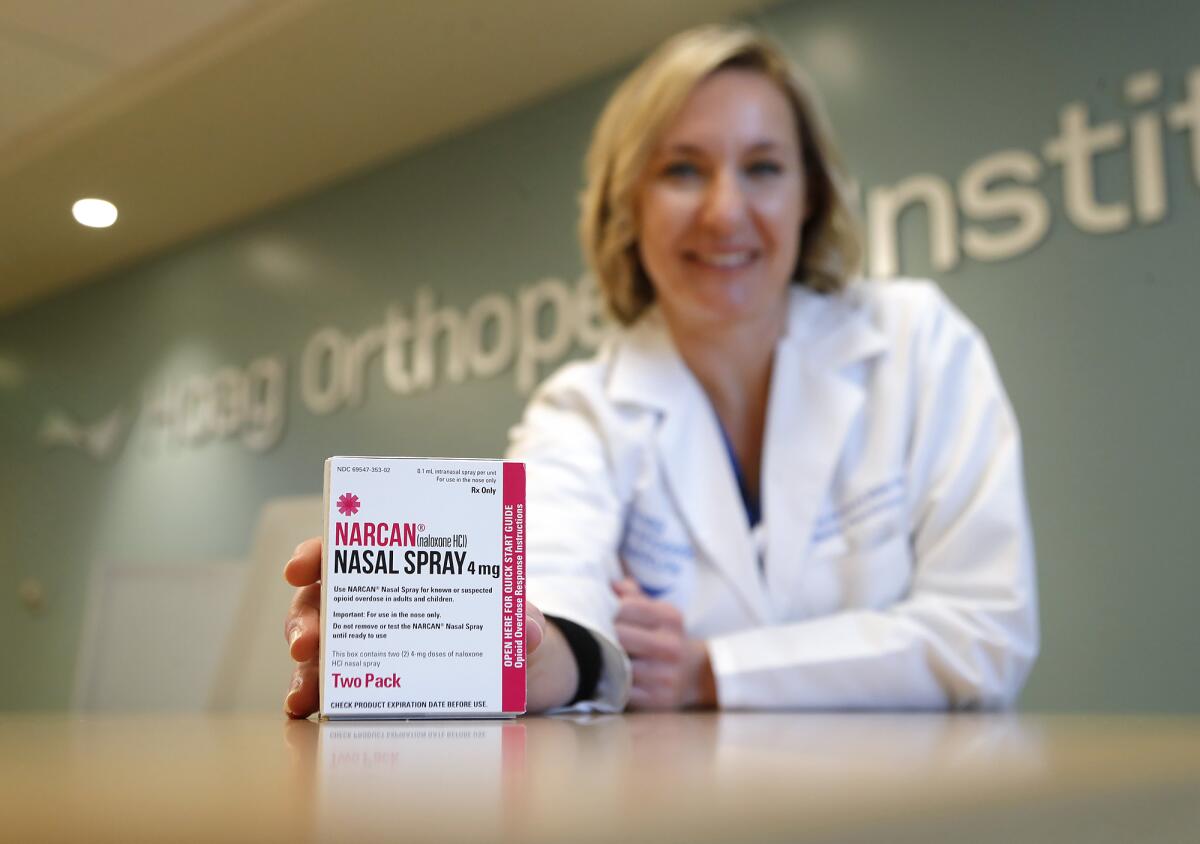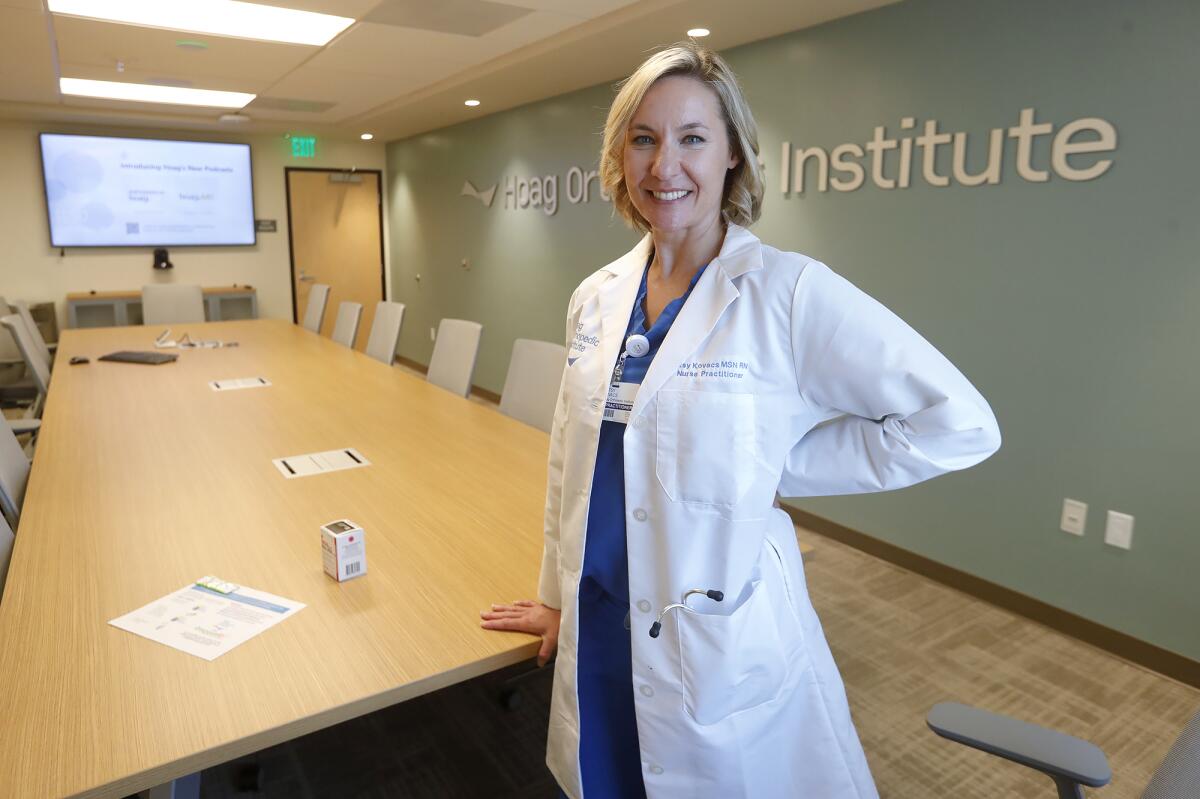Irvine nurse practitioner applauds FDA approval of over-the-counter Narcan to combat opioid epidemic

- Share via
Nurse practitioner Betsy Kovacs specializes in orthopedics, and she believes the best part about her job is helping people feel like themselves again.
“You have people coming in with so much pain, and their quality of life has just plummeted,” she said during an interview at the Hoag Orthopedic Institute in Irvine Wednesday. “They can’t do anything they can enjoy anymore because they’re hurting all the time. And to watch them just turn their life around, their quality of life is back, they’re able to go and do the things they love again ... We have a saying here: ‘Getting you back to you.’ And that’s what it really is.”
Many of her patients leave care with prolonged, arduous roads to recovery ahead of them. Managing pain becomes a large part of those journeys. So, powerful, potentially habit forming opioid-based medication is often prescribed to them.
Opioids like morphine or its exponentially more potent cousin, fentanyl, are effective painkillers. But taking too much of them can cause a person to stop breathing, resulting in a possibly fatal overdose.
So as a precaution, Kovacs and other nurse practitioners at Hoag prescribe Narcan, a chemical that blocks the effects of opioids, alongside those pain medications. And since 2021, they and many other hospitals have been handing out free doses funded by the state to people who either might not be able to afford them or have a prior history of drug abuse.

However, people who get a Narcan prescription represent only a portion of those at risk of overdose. As many as 80,411 opioid related deaths were reported in the U.S. in 2021, most of which were linked to the synthetic drug fentanyl, according to the National Institute on Drug Abuse. In comparison, just under 22,000 fatal cases had been logged in 2010 a number that had increased to 47,000 by 2017.
In Orange County, between 250 and 290 opioid-related deaths took place each year between 2016 and 2019 in Orange County, according to the Orange County Health Care Agency. That figure jumped to 501 in 2020.
The rapidly climbing death toll of the opioid epidemic is a large part of why the U.S. Food and Drug Administration approved Narcan for over-the-counter sale last month. The fast-acting inhibitor can bring someone who has stopped breathing back from the brink of death, is administered via a simple nasal spray and may be available at places like pharmacies and gas stations without a prescription by the end of this summer.
Many healthcare professionals have applauded the government’s decision to make Narcan more accessible amid rising rates of opioid abuse. The move has also been supported by advocates for the homeless community, a segment of the population disproportionately experiencing casualties connected to fentanyl use.
As many as 144 out of the 395 deaths of homeless people reported in Orange County in 2021 were linked to fentanyl, according to Orange County Sheriff’s and Coroner’s officials.
The impact of fentanyl on the homeless population over the years is something Edward Portillo, assistant program manager for the National Alliance on Mental Illness, has witnessed firsthand. He was the manager of the Bay Area Rescue Mission in San Francisco in 2016 before he joined NAMI and saw aspects of the lives of homeless people dealing with addiction that most may never witness. He said many of those he might find strung out or even causing disturbances in the street would be the same people he would share meals and meaningful conversations with after they got a chance to sober up at the shelter.
“You would see people on the street who were high, maybe acting out, but when they come to the rescue mission they would just have a cup of coffee,” Portillo said. “You could see their humanity.”
“There’s a disconnect people have,” he added. “They don’t see them as part of the community. They see them as a homeless person or a drug addict.”
Professionals hope OTC price is affordable
Currently, patients pay between $40 and $100 to fill a prescription of Narcan with a pharmacist. But the over-the-counter cost of Narcan hasn’t been announced yet, and Kovacs and others worry that it might not get to everyone who needs it if it’s priced too high.
“Is it going to be at an affordable cost? I hope and pray that it is because otherwise it’s not going to be effective if people can’t afford to buy it,” she said.
In California, free doses of the opioid inhibitor have been available through the state’s Narcan Distribution Program since 2018. So far, it has supplied over 2.2 million kits that have been given out by participating hospitals and community organizations.
One of the first groups to take part in the program was the Solace Foundation of Orange County. It partnered with NAMI to host a training session on the use of Narcan at the Melinda Hoag Smith Center for Healthy Living in Newport Beach on March 21.
As many as 45 people streamed the event on Zoom, and 28 showed up in person despite a torrential downpour that day, Portillo said. Much of the audience was comprised of mothers between the ages of 35 and 55, and most came to the hospital because they wanted to get Narcan.
“To have 28 people show up on a rainy day right next to a hospital at the Hope Center, it just goes to show that this is an epidemic,” Portillo said. “That’s how bad it is. It affects so many people. The need for it is there, so I’m not surprised that it’s being approved to go on shelves.”
All the latest on Orange County from Orange County.
Get our free TimesOC newsletter.
You may occasionally receive promotional content from the Daily Pilot.










